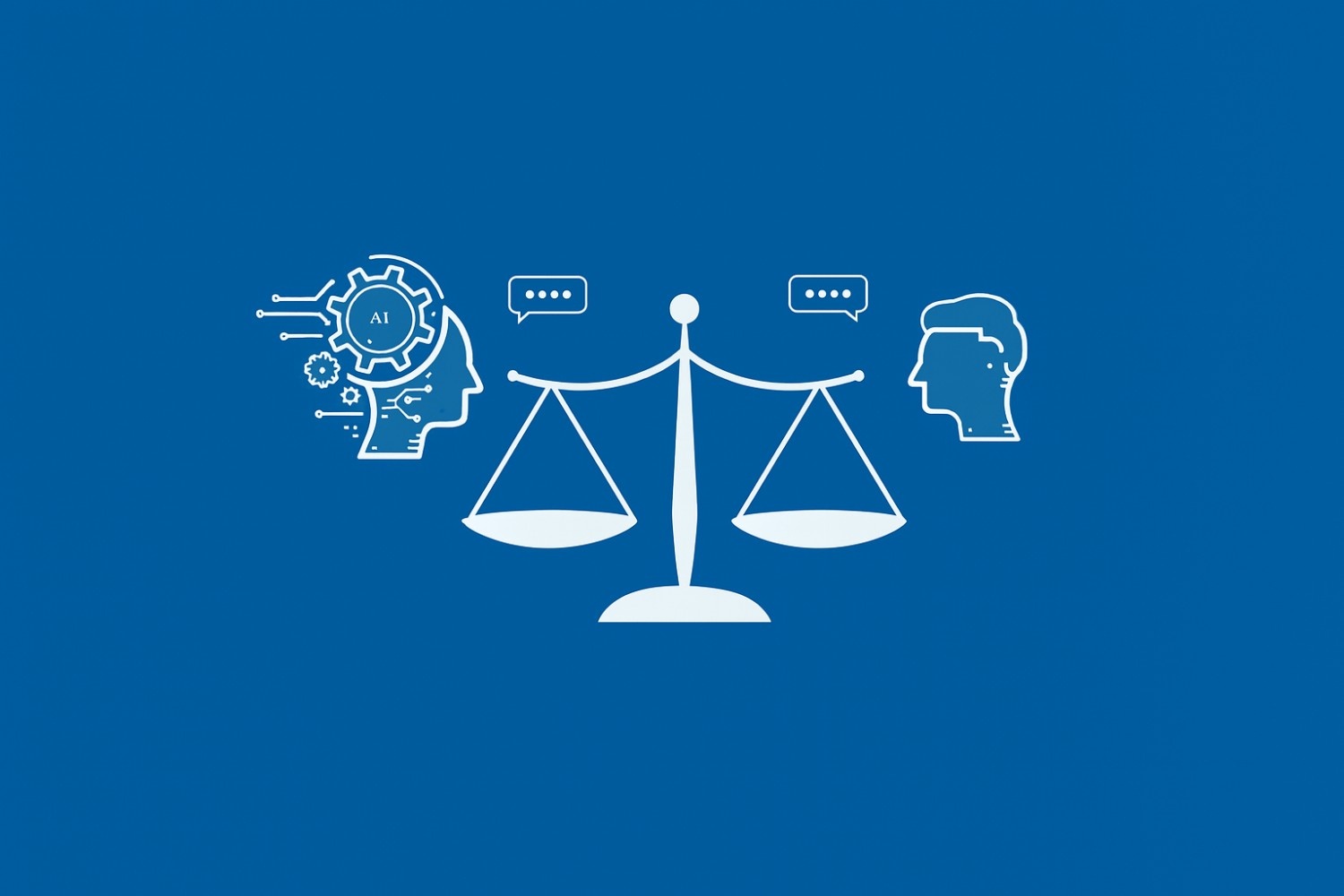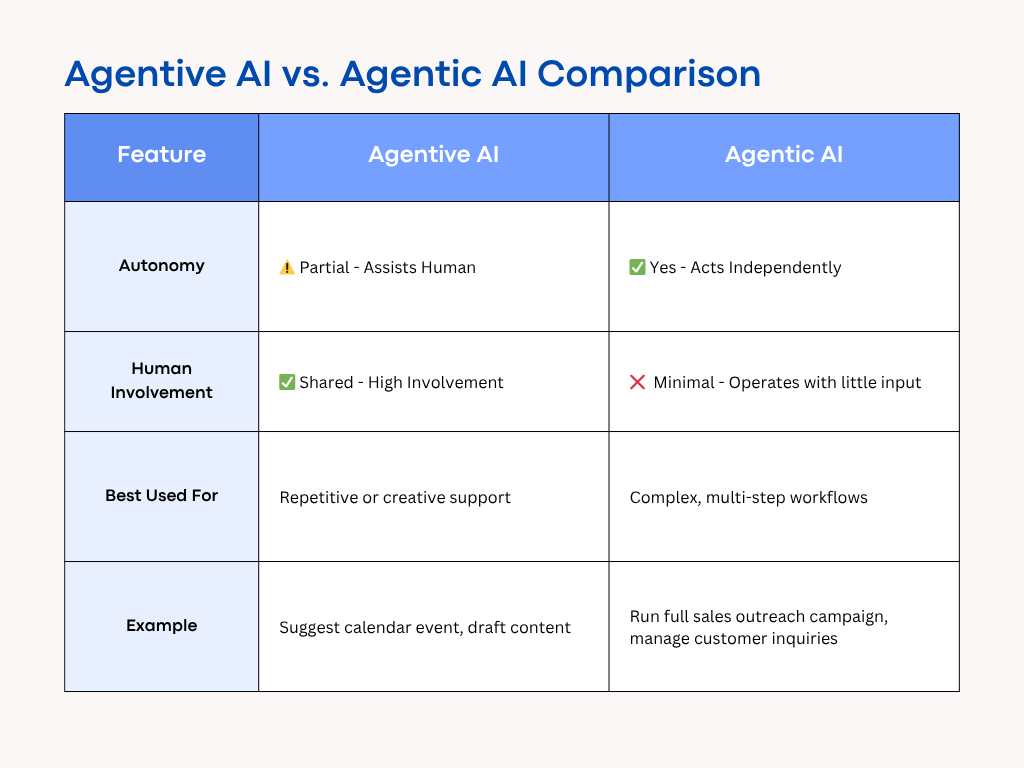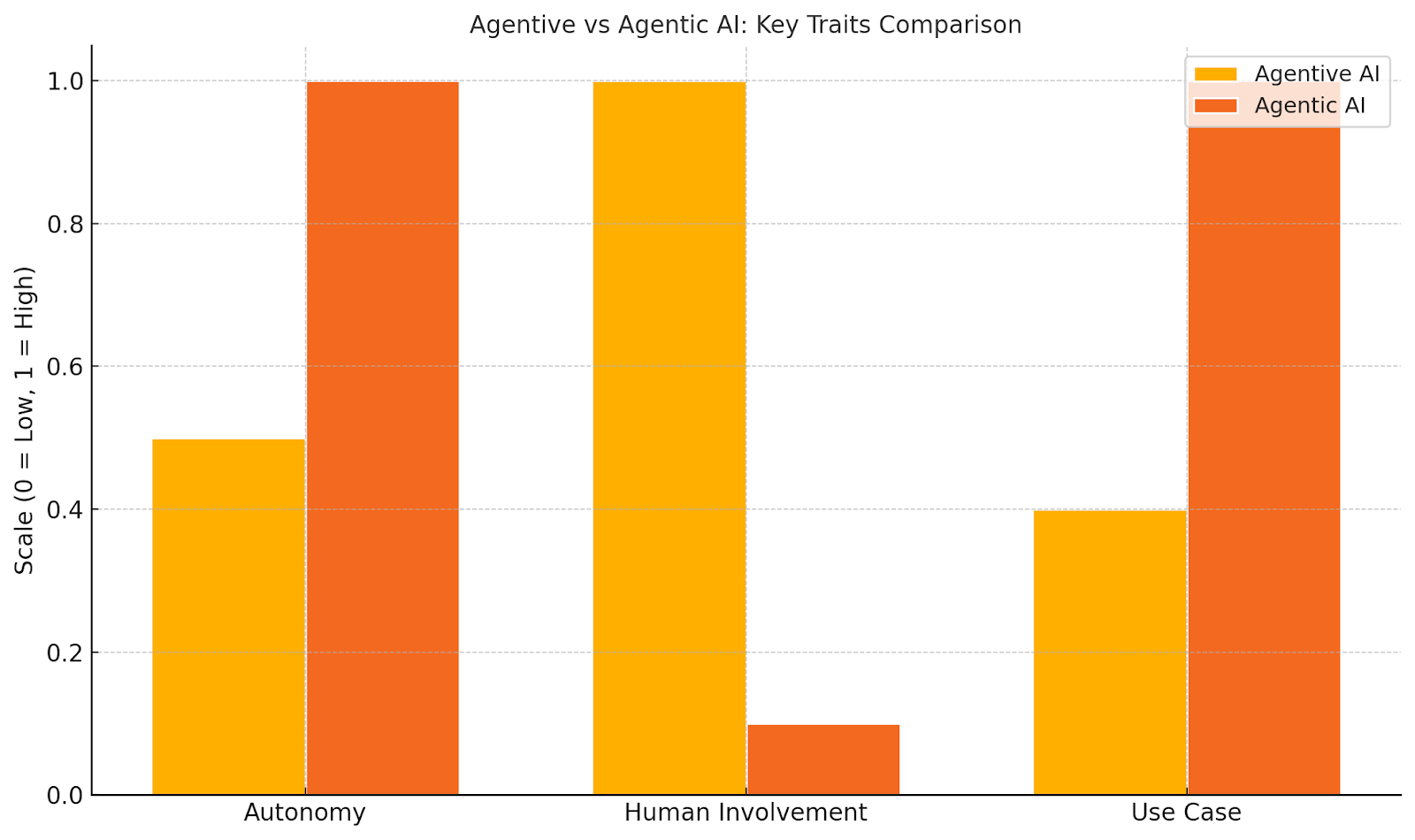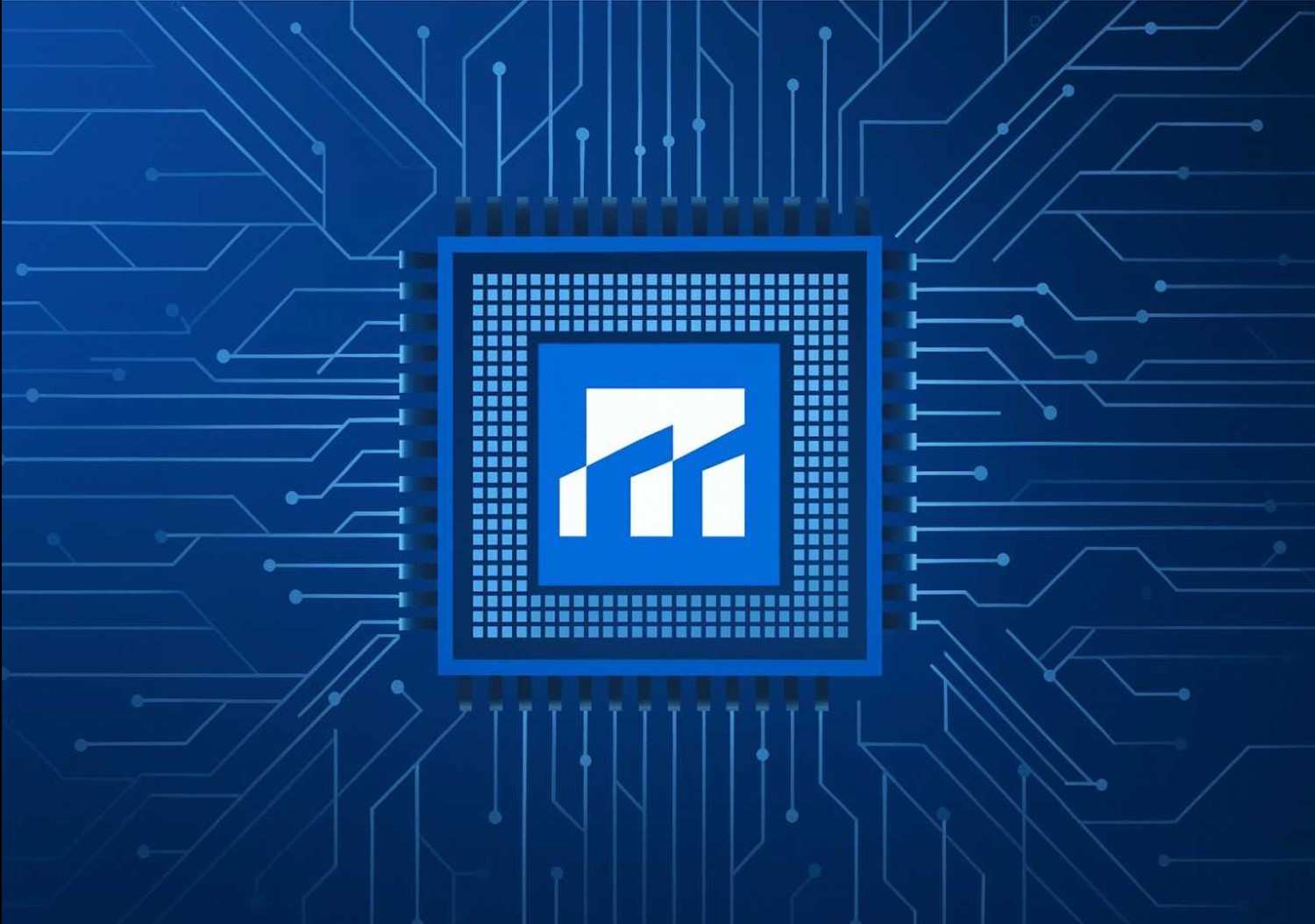Agentive AI vs. Agentic AI: What's the difference?

AI is in the driver’s seat, but are you still holding the wheel?
In today’s fast-paced business environment, AI is transforming how teams automate workflows and make decisions. As companies invest in smarter automation strategies, understanding the distinction between agentive AI and agentic AI becomes critical for business leaders aiming to stay ahead. While both types of AI can enhance efficiency and productivity, they serve fundamentally different roles within an organization. Recognizing when and how to deploy each type allows businesses to design more intelligent systems that balance control, adaptability, and scalability empowering teams to do more with less and driving long-term competitive advantage.
What is Agentive AI?
Agentive AI is designed to assist humans in completing tasks, not replace them. It works under human direction, often in the form of prompts or specific instructions. These systems enhance human productivity by automating routine or repetitive parts of a workflow. While they provide intelligent support, the final decisions and actions remain with the user.
Main Characteristics: Human-in-the-loop. Assists but doesn’t act independently.
Examples of agentive AI include:
- An AI scheduling assistant that recommends meeting times, but the user reviews and confirms the final schedule.
- You ask the AI to book a flight. It shows you flight options, and you select the one you want.
Agentive AI is great for repetitive workflows where humans want to maintain control but reduce effort. In a business context, this means higher productivity, reduced manual input, and faster task completion without full autonomy. It serves as a reliable assistant that supports, rather than replaces, human decision-making. This makes it ideal for industries where compliance, personalization, or human oversight is still critical to business success.
What is Agentic AI?
Agentic AI refers to systems that operate autonomously. They can set goals, make decisions, and take actions with minimal or no human input. Unlike agentive AI, which waits for human instructions, agentic AI is designed to plan, adapt, and execute complex workflows independently. These systems can analyze data, determine the best course of action, and carry out multi-step tasks without being prompted at every stage.
Main Characteristics: Self-directed and goal-driven. Operates without human-in-the-loop intervention.
Examples of agentic AI include:
- An AI sales agent that identifies potential leads, sends personalized outreach emails, follows up, and books meetings. All without human assistance.
- You give the AI a goal like “increase newsletter subscribers,” and it builds and launches a campaign across multiple channels on its own.
Agentic AI is ideal for B2B organizations looking to scale operations, reduce human bottlenecks, and fully automate routine or high-volume tasks. In a business context, it enables teams to achieve faster turnaround, greater efficiency, and consistent execution, especially in areas like customer support, finance, and lead management. While it requires upfront setup and clear guardrails, it frees up human resources for more strategic and creative work.
Key Differences Between Agentive and Agentic AI
Understanding the core differences between agentive and agentic AI is essential when deciding how to implement AI within your business operations. Below is a side-by-side comparison to highlight their capabilities and best use cases:


Knowing when to use each type of AI is key to maximizing its value in your business. Agentive AI is best suited for situations where human judgment, creativity, or decision-making remains essential, such as drafting proposals, summarizing meeting notes, or supporting content creation. It acts as a collaborative partner, enhancing productivity without removing the human touch. On the other hand, agentic AI excels when speed, consistency, and scalability take priority. It’s ideal for fully automating tasks like triaging support tickets, handling repetitive requests, or running end-to-end sales workflows, allowing your team to focus on higher-level strategy while the AI handles the execution.
How Businesses Benefit from Both
Agentive AI in Business Teams
Companies are increasingly turning to agentive AI to streamline daily tasks while keeping humans in the loop. It’s especially effective for work that requires context, judgment, or a creative touch. Sales teams use it to automatically summarize CRM notes after client calls, helping reps stay on top of follow-ups without getting buried in admin work. HR can auto-generate onboarding documents and benefits summaries, while operations teams use it to build internal playbooks from meeting transcripts, making key knowledge easily accessible across the organization.
With Mergepoint’s no-code AI agent builder, any business user even-no technical experience required—can create smart assistants that improve these processes. For example, an HR team can quickly set up an agent to welcome new hires, share required documents, and answer basic FAQs. It’s a practical way to boost efficiency without relying on developers or overhauling existing workflows.
Agentic AI in Business Workflows
Agentic AI takes automation a step further by independently managing multi-step tasks across platforms and departments. It’s ideal for scenarios where speed, consistency, and scale matter most. In customer support, it can triage inquiries, resolve common issues, and escalate urgent ones to human agents, reducing response times and improving efficiency. Finance teams use it to chase unpaid invoices and send follow-up reminders automatically. In sales, agentic AI pre-qualifies leads, extracts key data, and pushes prospects into the pipeline accelerating the sales process with minimal manual input.
With Mergepoint, teams can build and deploy these types of autonomous agents using a visual, no-code interface. For instance, a sales team can launch an AI agent that monitors inbound emails, extracts lead data, qualifies prospects based on preset rules, and updates the CRM in real time. This kind of end-to-end automation is already being adopted across industries from manufacturing to logistics—as seen in our blog on AI in industrial automation. To explore how Mergepoint connects with your tools, visit our Integrations page and schedule a demo.
How Mergepoint Empowers Business Teams with Both AIs
Mergepoint makes it easy to build and deploy both agentive and agentic AI—giving teams the flexibility to automate tasks with or without human input. Here’s how:
✅ No-code, drag-and-drop builder – Create custom workflows without writing a single line of code
✅ Support for both agentive and agentic AI – Build prompt-based assistants or fully autonomous agents
✅ Seamless tool integrations – Works with Gmail, Slack, CRMs, and more
✅ Proven success across industries – Used in finance, logistics, SaaS, customer support, and more
✅ Flexible and scalable – Automate everything from document generation to lead follow-up
Explore our industry use cases and platform capabilities to see how Mergepoint can support your team.
In a Nutshell
Agentive AI and agentic AI represent two distinct, yet complementary, approaches to business automation. Agentive AI is ideal when human oversight and control are essential helping teams streamline tasks like scheduling, document generation, or data input without relinquishing decision-making power. It enhances productivity and supports day-to-day workflows while keeping the human at the center. On the other hand, agentic AI takes automation a step further, operating with autonomy to handle entire processes such as lead qualification, customer service triage, or invoice follow-up. By acting independently, it allows businesses to scale operations, respond faster, and unlock new efficiencies across departments.
Understanding when to apply agentive vs. agentic AI is critical to building a balanced, future-ready automation strategy. Whether you're aiming to boost internal productivity or fully automate external workflows, combining both types of AI within the right context can deliver transformative results. Mergepoint empowers businesses to build and deploy both with ease through our no-code AI agent platform.
Ready to automate smarter and scale faster? Book a demo today and see how Mergepoint helps your team turn ideas into intelligent action—no code required.





